Unit 5 What are the shirts made of?表格式教案(5课时)
文档属性
| 名称 | Unit 5 What are the shirts made of?表格式教案(5课时) | 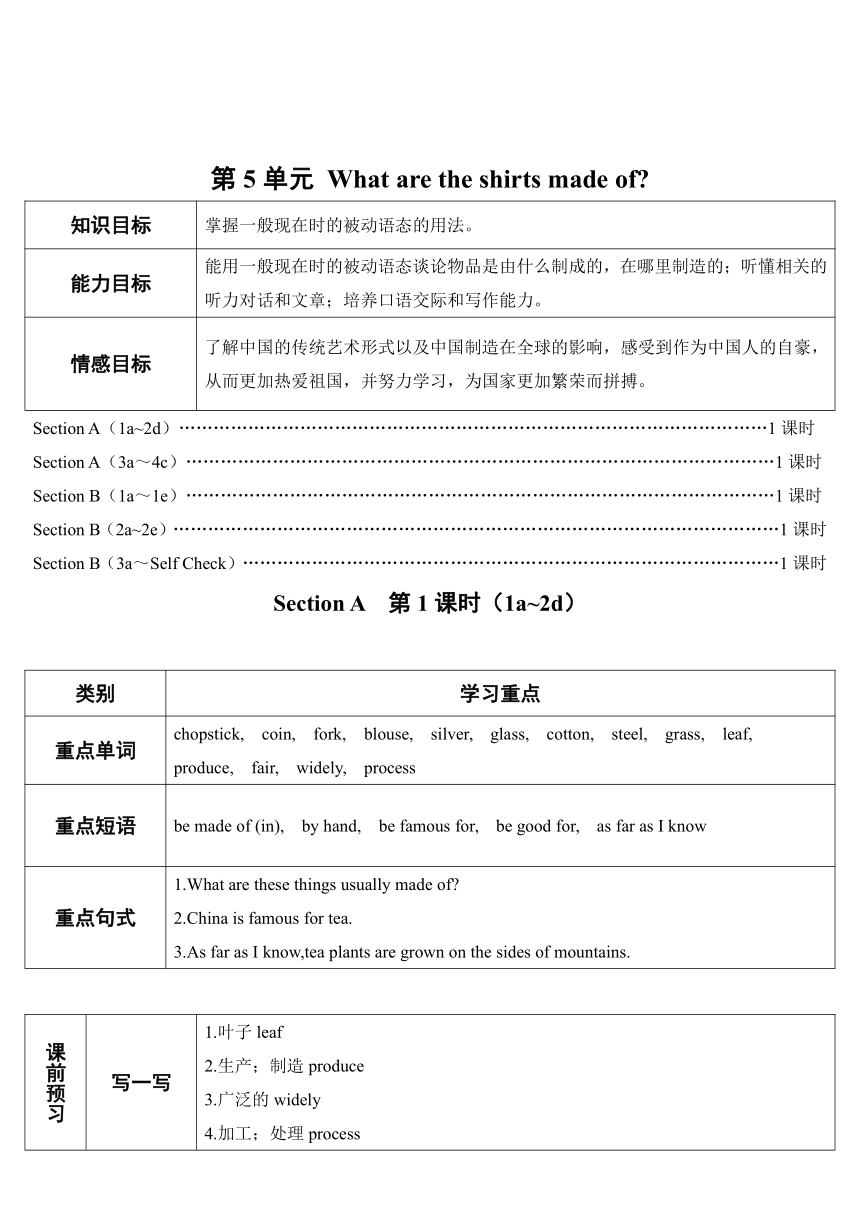 | |
| 格式 | doc | ||
| 文件大小 | 179.0KB | ||
| 资源类型 | 教案 | ||
| 版本资源 | 人教新目标(Go for it)版 | ||
| 科目 | 英语 | ||
| 更新时间 | 2021-09-05 11:48:23 | ||
图片预览

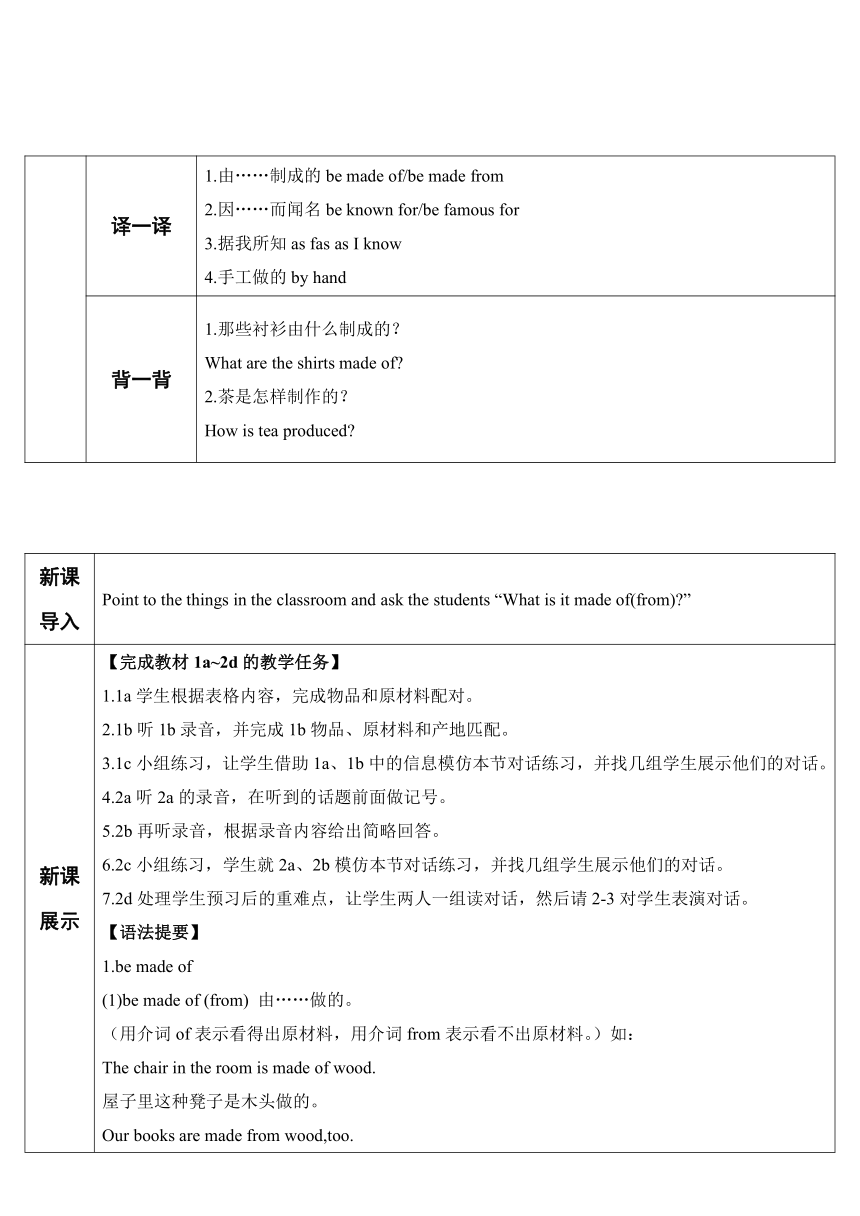
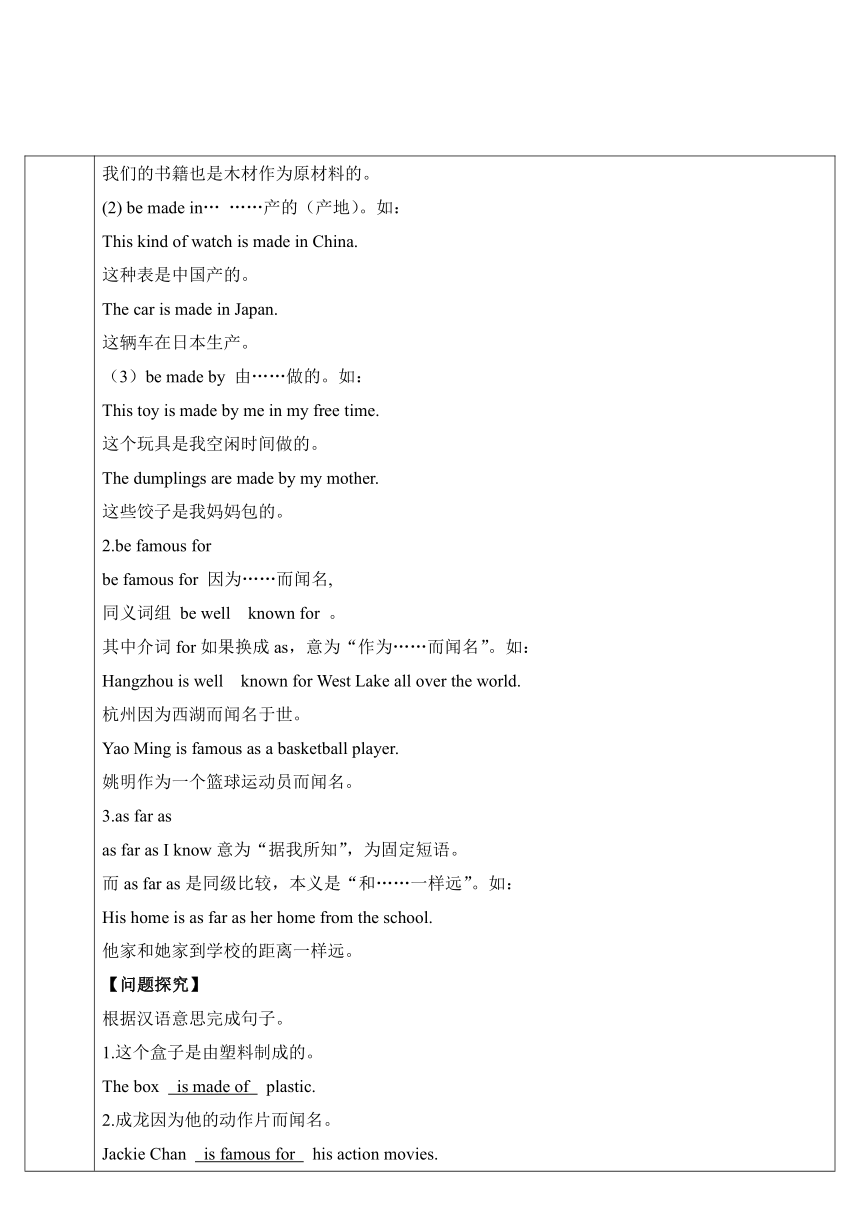
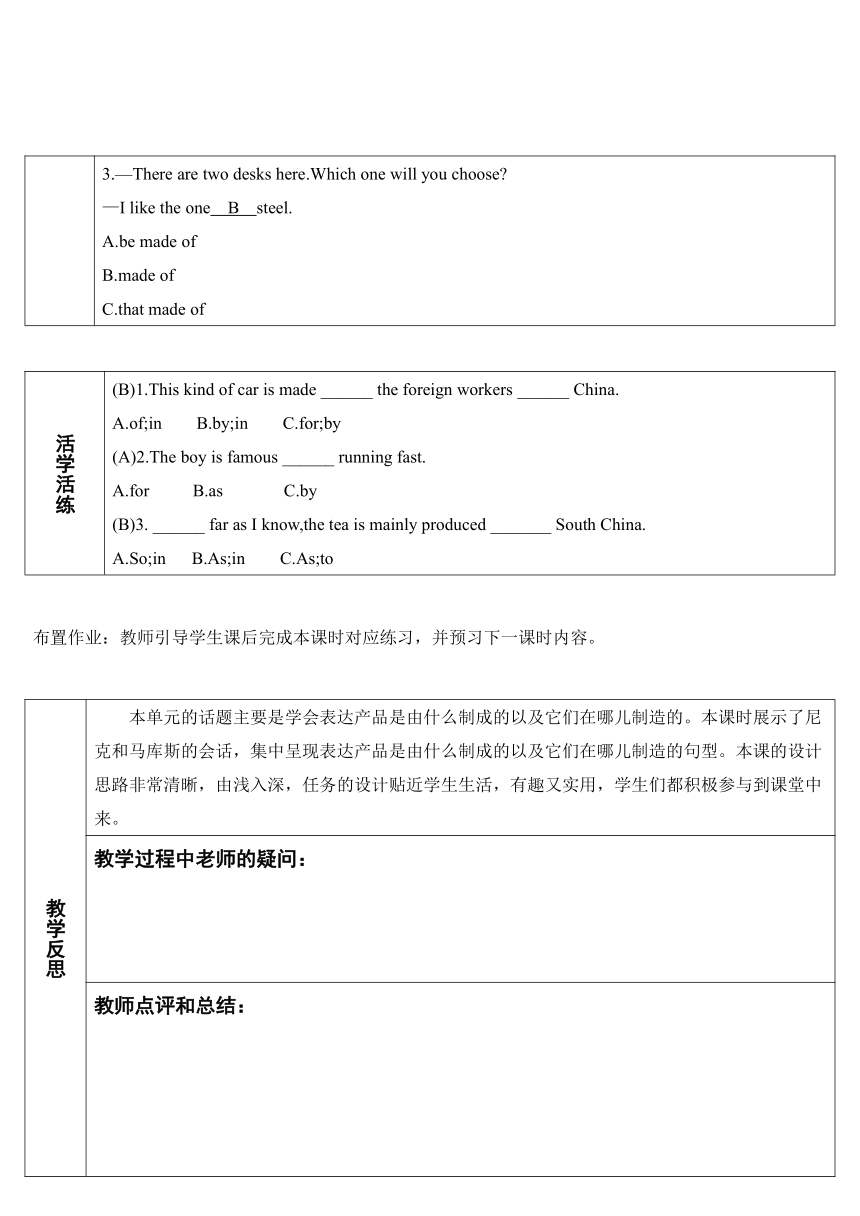
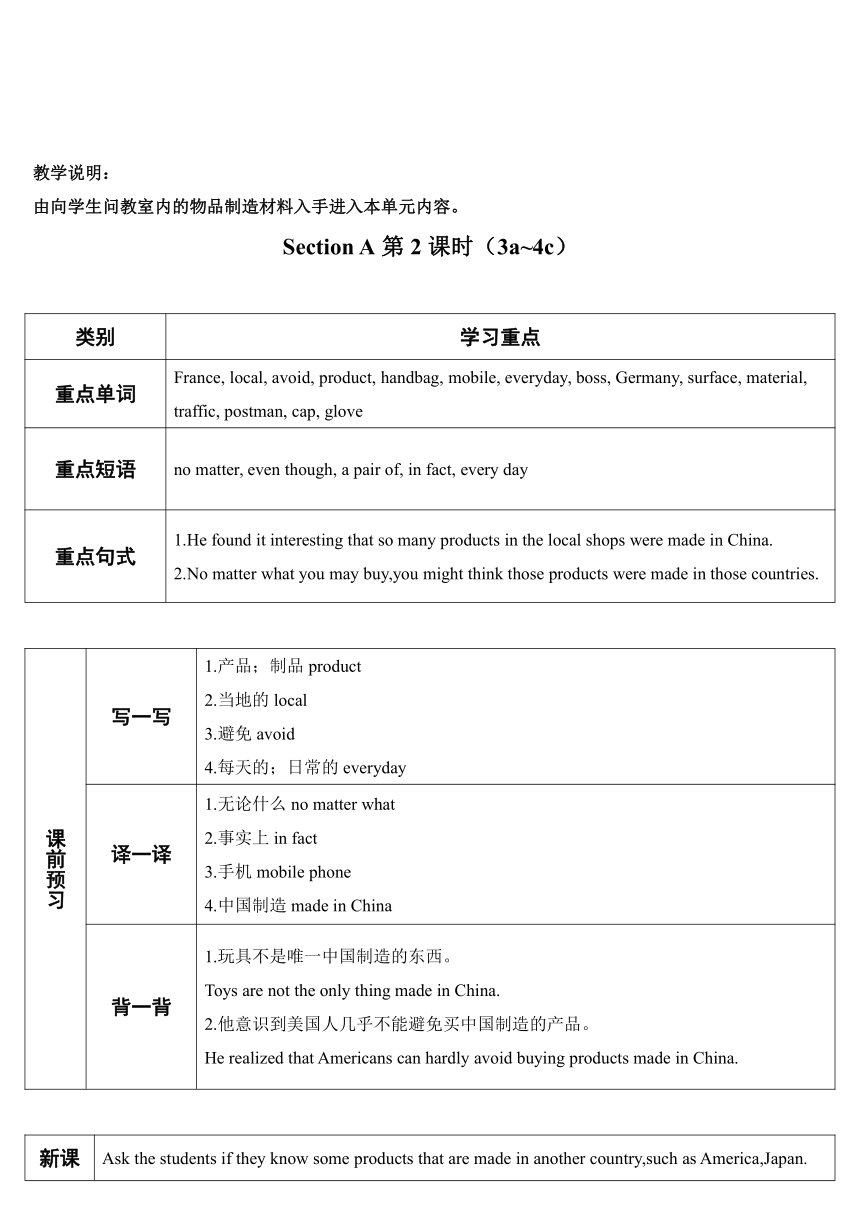
文档简介
第5单元
What
are
the
shirts
made
of?
知识目标
掌握一般现在时的被动语态的用法。
能力目标
能用一般现在时的被动语态谈论物品是由什么制成的,在哪里制造的;听懂相关的听力对话和文章;培养口语交际和写作能力。
情感目标
了解中国的传统艺术形式以及中国制造在全球的影响,感受到作为中国人的自豪,从而更加热爱祖国,并努力学习,为国家更加繁荣而拼搏。
Section
A(1a~2d)…………………………………………………………………………………………1课时
Section
A(3a~4c)…………………………………………………………………………………………1课时
Section
B(1a~1e)…………………………………………………………………………………………1课时
Section
B(2a~2e)……………………………………………………………………………………………1课时
Section
B(3a~Self
Check)…………………………………………………………………………………1课时
Section
A
第1课时(1a~2d)
类别
学习重点
重点单词
chopstick,
coin,
fork,
blouse,
silver,
glass,
cotton,
steel,
grass,
leaf,
produce,
fair,
widely,
process
重点短语
be
made
of
(in),
by
hand,
be
famous
for,
be
good
for,
as
far
as
I
know
重点句式
1.What
are
these
things
usually
made
of?2.China
is
famous
for
tea.3.As
far
as
I
know,tea
plants
are
grown
on
the
sides
of
mountains.
课前预习
写一写
1.叶子leaf2.生产;制造produce3.广泛的widely4.加工;处理process
译一译
1.由……制成的be
made
of/be
made
from2.因……而闻名be
known
for/be
famous
for3.据我所知as
fas
as
I
know4.手工做的by
hand
背一背
1.那些衬衫由什么制成的?What
are
the
shirts
made
of?2.茶是怎样制作的?How
is
tea
produced?
新课导入
Point
to
the
things
in
the
classroom
and
ask
the
students
“What
is
it
made
of(from)?”
新课展示
【完成教材1a~2d的教学任务】1.1a学生根据表格内容,完成物品和原材料配对。2.1b听1b录音,并完成1b物品、原材料和产地匹配。3.1c小组练习,让学生借助1a、1b中的信息模仿本节对话练习,并找几组学生展示他们的对话。4.2a听2a的录音,在听到的话题前面做记号。5.2b再听录音,根据录音内容给出简略回答。6.2c小组练习,学生就2a、2b模仿本节对话练习,并找几组学生展示他们的对话。7.2d处理学生预习后的重难点,让学生两人一组读对话,然后请2-3对学生表演对话。【语法提要】1.be
made
of(1)be
made
of
(from)
由……做的。(用介词of表示看得出原材料,用介词from表示看不出原材料。)如:The
chair
in
the
room
is
made
of
wood.屋子里这种凳子是木头做的。Our
books
are
made
from
wood,too.我们的书籍也是木材作为原材料的。(2)
be
made
in…
……产的(产地)。如:This
kind
of
watch
is
made
in
China.这种表是中国产的。The
car
is
made
in
Japan.这辆车在日本生产。(3)be
made
by
由……做的。如:This
toy
is
made
by
me
in
my
free
time.这个玩具是我空闲时间做的。The
dumplings
are
made
by
my
mother.这些饺子是我妈妈包的。2.be
famous
forbe
famous
for
因为……而闻名,同义词组
be
well?known
for
。其中介词for如果换成as,意为“作为……而闻名”。如:Hangzhou
is
well?known
for
West
Lake
all
over
the
world.杭州因为西湖而闻名于世。Yao
Ming
is
famous
as
a
basketball
player.姚明作为一个篮球运动员而闻名。3.as
far
asas
far
as
I
know意为“据我所知”,为固定短语。而as
far
as是同级比较,本义是“和……一样远”。如:His
home
is
as
far
as
her
home
from
the
school.他家和她家到学校的距离一样远。【问题探究】根据汉语意思完成句子。1.这个盒子是由塑料制成的。The
box
is
made
of
plastic.2.成龙因为他的动作片而闻名。Jackie
Chan
is
famous
for
his
action
movies.3.—There
are
two
desks
here.Which
one
will
you
choose?—I
like
the
one
B
steel.A.be
made
ofB.made
ofC.that
made
of
活学活练
(B)1.This
kind
of
car
is
made
______
the
foreign
workers
______
China.A.of;in
B.by;in
C.for;by
(A)2.The
boy
is
famous
______
running
fast.A.for
B.as
C.by(B)3.
______
far
as
I
know,the
tea
is
mainly
produced
_______
South
China.A.So;in
B.As;in
C.As;to
布置作业:教师引导学生课后完成本课时对应练习,并预习下一课时内容。
教学反思
本单元的话题主要是学会表达产品是由什么制成的以及它们在哪儿制造的。本课时展示了尼克和马库斯的会话,集中呈现表达产品是由什么制成的以及它们在哪儿制造的句型。本课的设计思路非常清晰,由浅入深,任务的设计贴近学生生活,有趣又实用,学生们都积极参与到课堂中来。
教学过程中老师的疑问:
教师点评和总结:
教学说明:
由向学生问教室内的物品制造材料入手进入本单元内容。
Section
A第2课时(3a~4c)
类别
学习重点
重点单词
France,
local,
avoid,
product,
handbag,
mobile,
everyday,
boss,
Germany,
surface,
material,
traffic,
postman,
cap,
glove
重点短语
no
matter,
even
though,
a
pair
of,
in
fact,
every
day
重点句式
1.He
found
it
interesting
that
so
many
products
in
the
local
shops
were
made
in
China.2.No
matter
what
you
may
buy,you
might
think
those
products
were
made
in
those
countries.
课前预习
写一写
1.产品;制品product2.当地的local3.避免avoid4.每天的;日常的everyday
译一译
1.无论什么no
matter
what2.事实上in
fact3.手机mobile
phone4.中国制造made
in
China
背一背
1.玩具不是唯一中国制造的东西。Toys
are
not
the
only
thing
made
in
China.2.他意识到美国人几乎不能避免买中国制造的产品。He
realized
that
Americans
can
hardly
avoid
buying
products
made
in
China.
新课导入
Ask
the
students
if
they
know
some
products
that
are
made
in
another
country,such
as
America,Japan.
新课展示
【完成教材3a~4c的教学任务】1.3a学生快速阅读本节文章,找出康健想买的两样物品和其产地。2.3b学生再次阅读该文章,找出本节问题的答案。3.3c学生再次阅读该文章,找出黑体单词指代的意思。4.处理3a重难点,学生朗读。5.4a学生用所给单词的正确形式填空。6.4b学生根据表格提供的信息写文段。7.4c学生按本节要求填表,让若干学生报告自己和同伴的情况。【语法提要】1.no
matterno
matter意为“无论;不论”,它与what,where,when,which等疑问词连用,表示“无论……;不管……”,用来引导让步状语从句。“no
matter+疑问词”相当于“疑问词+?ever”。如:no
matter
how—however
no
matter
where—whereverno
matter
who—whoever
no
matter
when—whenever2.avoidavoid作动词,意为“避免;回避”,其后可接名词、代词、动名词作宾语。如:I
left
early
to
avoid
the
rush
hour.我早早动身以避开交通高峰期。You
should
avoid
being
late
for
your
class.你应该避免上课迟到。3.find
it+形容词+that从句“find
it+形容词+that从句”意为“发现……(是怎样的),其中it作find的形式宾语,that引导的从句为真正的宾语,形容词作find的宾语补足语。【问题探究】1.He
seems
to
avoid
meeting
(meet)
me
all
the
time.2.
B
you
go,you
should
remember
your
home.A.No
matter
whenB.No
matter
whereC.No
matter
whatD.No
matter
who3.I
found
that
visiting
China
is
very
interesting.(改为简单句)I
found
it
interesting
to
visit
China.
活学活练
(B)1.—
_______
happens,there
is
a
way
to
solve
it.—I
agree
with
what
you
said.A.No
matter
how
B.No
matter
what
C.No
matter
who(C)2.The
young
children
should
learn
some
traffic
rules
to
C
road
accidents.A.break
B.obey
C.avoid(C)3.I
find
______
funny
that
he
dresses
up
as
a
clown.A.it
B.is
C.this
D.that
布置作业:教师引导学生课后完成本课时对应练习,并预习下一课时内容。
教学反思
本节课课堂容量大,活动比较多,但重点词汇和句型不多,围绕本节课重点,我先带领学生完成3a、3b、3c的阅读任务,在此基础上再通过Grammar
Focus引导学生对Section
A的重点句型进行总结,最后通过4a、4b、4c的练习引导学生掌握被动语态的基本用法。
教学过程中老师的疑问:
教师点评和总结:
教学说明:
询问学生熟悉的一些国外品牌情况,为学习3a作铺垫。
Section
B第3课时(1a~1e)
类别
学习重点
重点单词
international
重点短语
on
a
vacation,
different
kinds
of
重点句式
1.That
sounds
interesting.2.…didn’t
know
that
kite
flying
could
be
so
exciting.
课前预习
写一写
国际的international
译一译
1.弄清;查明find
out2.去度假go
on
vacation3.了解learn/know
about4.不同种类的different
kinds
of
背一背
1.你去哪里度假了?Where
did
you
go
on
vacation?2.国际风筝节每年举行。The
international
kite
festival
is
held
every
year.
新课导入
T:Do
you
know
how
to
fly
a
kite?S1:Yes.It’s
very
easy.T:Do
you
know
how
to
make
a
kite?S2:…
新课展示
【完成教材1a~1e的教学任务】1.1a学生填写制作风筝的材料。2.1b学生根据听力选择答案。3.1c学生听听力材料,填写字母。4.1d学生再听听力材料,根据所听内容填空。5.1e学生根据1b-1d的信息练习对话。【语法提要】1.soundsound听起来;look看起来;smell闻起来;taste尝起来。其后接形容词作表语。如:The
apple
tastes
sweet.这个苹果尝起来甜。sound
like听起来像;look
like看起来像;smell
like闻起来像;taste
like尝起来像。其后接名词作宾语。如:Her
round
face
looks
like
an
apple.她的圆脸看起来像苹果。2.kite
flyingkite
flying放风筝,类似的还有:
tree
planting
栽树。如:March
12
is
Tree-planting
Day.三月十二是植树节。【问题探究】1.The
phrases
are
on
the
blackboard.Please
A
too.A.write
them
downB.write
down
themC.write
it
down2.I
saw
many
different
C
of
shoes
in
the
shop.A.kind
B.type
C.kinds
活学活练
(A)1.He
who
is
sitting
there
______
.A.looks
very
oldB.looks
like
very
oldC.looks
an
old
man(C)2.
________
is
hard
for
the
short
boy.A.Clean
the
blackboardB.Cleans
the
blackboardC.Cleaning
the
blackboard
布置作业:教师引导学生课后完成本课时对应练习,并预习下一课时内容。
教学反思
本节课主要通过听说练习引导学生完成学习重点,并在听说过程中完成重点单词和短语的学习。其实词汇和句子的学习关键在于运用,那么,本节课的听说教学就给了学生大量的听说练习的机会。
教学过程中老师的疑问:
教师点评和总结:
教学说明:
通过提问,进入本节课有关风筝的话题。
Section
B第4课时(2a~2e)
类别
学习重点
重点单词
its,
form,
balloon,
scissors,
lively,
heat,
complete
重点短语
in
life,
according
to,
in
trouble,
ask
for,
be
covered
with,
such
as,
turn…into,
send
out,
rise
into,
put…on
重点句式
1.These
usually
try
to
show
the
things
that
are
important
in
life,such
as
love,beauty
and
family.2.He
sent
them
out
to
ask
for
help
when
in
trouble.
课前预习
写一写
1.形式;类型form2.生气勃勃的lively3.热;高温heat4.完成complete
译一译
1.例如such
as2.把……变成turn…into3.根据according
to4.处于困境in
trouble5.被覆盖be
covered
with6.升入rise
into
背一背
1.当孔明灯被点燃时,它们慢慢地升入空中。When
the
lanterns
are
lit,they
slowly
rise
into
the
air.2.它们被视为快乐和美好愿望的象征。They
are
seen
as
bright
symbols
of
happiness
and
good
wishes.
新课导入
T:We
have
already
learned
the
information
about
kites.Also,there
are
many
kinds
of
traditional
arts
in
China,such
as
paper
cutting,Chinese
clay
art,sky
lanterns.Can
any
of
you
make
paper
cutting?
新课展示
【完成教材2a~2e的教学任务】1.2a让学生口头表述制作剪纸等传统工艺所需的材料及制作过程。2.2b让学生浏览该文段,完成表格。3.让学生再读该文段,口头回答本节问题。4.2c处理2b重难点,学生朗读。5.2d学生用所给词组的适当形式完成句子。6.2e学生分组展开讨论并报告讨论结果。【语法提要】1.such
assuch
as,for
example和like都可用来举例,但用法有所不同。(1)such
as也可作“例如”讲,用来列举同类人或事物中的几个例子。如:Boys
such
as
John
and
James
are
very
friendly.像约翰和詹姆斯这样的男孩都很友好。
I
like
drinks,such
as
tea
and
soda.我喜欢像茶、汽水之类的饮料。(2)for
example作“例如”讲时,一般只以同类事物或人中的“一个”为例,作插入语,用逗号隔开,可置于句首、句中或句末。如:He,for
example,is
a
good
student.例如,他就是个好学生。For
example,air
can’t
be
seen.例如,空气是看不见的。(3)like也常用来表示举例,可与such
as互换。如:Some
students,like/such
as
Li
Lei
and
Wang
Hao
do
not
need
to
go.一些同学,例如李雷、王浩不需要去。2.in
troublein
trouble处于困境中,有麻烦。如:We
may
have
been
in
trouble
for
a
while.我们可能暂时会有麻烦。Worst
of
all,there’s
no
one
to
talk
to
me
and
cheer
me
up
when
I’m
in
trouble.最糟糕的是,当我处于困境时,没有人跟我说话使我高兴起来。Jack
got
in
trouble
because
he
copied
my
test.杰克麻烦大了,因为他考试抄我的。【问题探究】1.Don’t
trouble
troubles
when
troubles
trouble
you.(trouble)不要惹是生非。2.The
pieces
are
A
shaped
by
the
boy
than
the
girl.A.much
more
carefullyB.much
more
carefulC.more
much
carefully
活学活练
(A)1.—Please
introduce
yourself
to
us,OK?—My
full
name
is
James
Allen
Green._______
,Green
is
my
family
name.A.For
exampleB.Such
asC.Like(B)2.Don’t
be
afraid
______
me
when
you’re
_______
.A.trouble;in
troubleB.to
trouble;in
troubleC.to
trouble;to
trouble
布置作业:教师引导学生课后完成本课时对应练习,并预习下一课时内容。
教学反思
本课时为阅读课,任务型阅读在新教材中体现得更加明晰。阅读前、阅读中、阅读后的任务在课本中很清晰地列出来,只要按照课本的思路引导学生一步步地来,阅读的任务会循序渐进地完成。
教学过程中老师的疑问:
教师点评和总结:
教学说明:
通过介绍和让学生做简单的剪纸作品,为学习2a、2b作准备。
Section
B第5课时(3a~Self
Check)
类别
学习重点
重点短语
be
famous
for,
be
made
of
/from/in
重点句式
1.These
can
be
food,artwork
or
any
other
products.2.The
underground
parking
lot
is
closed
at
midnight
every
day.
译一译
1.被……制成be
made
by2.在……很有名be
famous
in3.被用来be
used
for4.停车场parking
lot
背一背
1.父母和学生昨晚被邀请去参加学校音乐会。Parents
and
students
were
invited
to
the
school
concert
last
night.2.有许多关于语言学习的研究。There
is
a
lot
of
research
on
how
languages
are
learnt.
新课导入
Say
there
are
many
other
art
forms
in
the
other
places
in
China.Ask
what
they
are.
新课展示
【完成教材3a~Self
Check的教学任务】1.3a结合情景导入,让学生讨论、填表。2.3b学生根据所填表格写文段,然后请部分学生发言。3.Self
Check
1学生填表,列出其常用物品名称、材料和产地。4.Self
Check
2学生根据其所填表格写出完整的句子。5.Self
Check
3学生用所给单词完成句子。【语法提要】1.any
otherany
other任何其他的。如:He
is
taller
than
any
other
student
in
his
class.他比班上其他的学生都要高。one…the
other,一个……另外一个……。如:I
have
two
pens.One
is
red,the
other
is
black.我有两只钢笔,一只红色,一只黑色。2.closedopen有动词和形容词性,但单词close的形容词是closed(也可以理解为被动结构,过去分词)。如:The
door
is
open,but
the
window
is
closed.门开着,但窗户是关着的。【问题探究】1.It
is
said
(say)
that
it
is
raining.2.I
didn’t
go
to
the
party
because
I
wasn’t
invited
(not
invite).
活学活练
(B)1.I
think
English
is
more
difficult
than
_______
subject.A.the
otherB.any
otherC.another(A)2.The
drawer
is_______
.Please
_______
it.A.open;closeB.close;openC.opened;closed
布置作业:教师引导学生课后完成本课时对应练习,并预习下一课时内容。
教学反思
本课时要完成两个任务,一是通过Self
Check对本单元进行小结,并通过练习加以巩固,二是通过3a、3b的活动完成对本单元语言的综合运用,写一篇作文介绍家乡的特产,因而这节课相对来说容量较大,对Self
Check可通过预习提前完成,对于写作可通过3a、3b的活动提示一步步地完成。
教学过程中老师的疑问:
教师点评和总结:
教学说明:
通过询问,过渡到本地艺术形式。
PAGE
What
are
the
shirts
made
of?
知识目标
掌握一般现在时的被动语态的用法。
能力目标
能用一般现在时的被动语态谈论物品是由什么制成的,在哪里制造的;听懂相关的听力对话和文章;培养口语交际和写作能力。
情感目标
了解中国的传统艺术形式以及中国制造在全球的影响,感受到作为中国人的自豪,从而更加热爱祖国,并努力学习,为国家更加繁荣而拼搏。
Section
A(1a~2d)…………………………………………………………………………………………1课时
Section
A(3a~4c)…………………………………………………………………………………………1课时
Section
B(1a~1e)…………………………………………………………………………………………1课时
Section
B(2a~2e)……………………………………………………………………………………………1课时
Section
B(3a~Self
Check)…………………………………………………………………………………1课时
Section
A
第1课时(1a~2d)
类别
学习重点
重点单词
chopstick,
coin,
fork,
blouse,
silver,
glass,
cotton,
steel,
grass,
leaf,
produce,
fair,
widely,
process
重点短语
be
made
of
(in),
by
hand,
be
famous
for,
be
good
for,
as
far
as
I
know
重点句式
1.What
are
these
things
usually
made
of?2.China
is
famous
for
tea.3.As
far
as
I
know,tea
plants
are
grown
on
the
sides
of
mountains.
课前预习
写一写
1.叶子leaf2.生产;制造produce3.广泛的widely4.加工;处理process
译一译
1.由……制成的be
made
of/be
made
from2.因……而闻名be
known
for/be
famous
for3.据我所知as
fas
as
I
know4.手工做的by
hand
背一背
1.那些衬衫由什么制成的?What
are
the
shirts
made
of?2.茶是怎样制作的?How
is
tea
produced?
新课导入
Point
to
the
things
in
the
classroom
and
ask
the
students
“What
is
it
made
of(from)?”
新课展示
【完成教材1a~2d的教学任务】1.1a学生根据表格内容,完成物品和原材料配对。2.1b听1b录音,并完成1b物品、原材料和产地匹配。3.1c小组练习,让学生借助1a、1b中的信息模仿本节对话练习,并找几组学生展示他们的对话。4.2a听2a的录音,在听到的话题前面做记号。5.2b再听录音,根据录音内容给出简略回答。6.2c小组练习,学生就2a、2b模仿本节对话练习,并找几组学生展示他们的对话。7.2d处理学生预习后的重难点,让学生两人一组读对话,然后请2-3对学生表演对话。【语法提要】1.be
made
of(1)be
made
of
(from)
由……做的。(用介词of表示看得出原材料,用介词from表示看不出原材料。)如:The
chair
in
the
room
is
made
of
wood.屋子里这种凳子是木头做的。Our
books
are
made
from
wood,too.我们的书籍也是木材作为原材料的。(2)
be
made
in…
……产的(产地)。如:This
kind
of
watch
is
made
in
China.这种表是中国产的。The
car
is
made
in
Japan.这辆车在日本生产。(3)be
made
by
由……做的。如:This
toy
is
made
by
me
in
my
free
time.这个玩具是我空闲时间做的。The
dumplings
are
made
by
my
mother.这些饺子是我妈妈包的。2.be
famous
forbe
famous
for
因为……而闻名,同义词组
be
well?known
for
。其中介词for如果换成as,意为“作为……而闻名”。如:Hangzhou
is
well?known
for
West
Lake
all
over
the
world.杭州因为西湖而闻名于世。Yao
Ming
is
famous
as
a
basketball
player.姚明作为一个篮球运动员而闻名。3.as
far
asas
far
as
I
know意为“据我所知”,为固定短语。而as
far
as是同级比较,本义是“和……一样远”。如:His
home
is
as
far
as
her
home
from
the
school.他家和她家到学校的距离一样远。【问题探究】根据汉语意思完成句子。1.这个盒子是由塑料制成的。The
box
is
made
of
plastic.2.成龙因为他的动作片而闻名。Jackie
Chan
is
famous
for
his
action
movies.3.—There
are
two
desks
here.Which
one
will
you
choose?—I
like
the
one
B
steel.A.be
made
ofB.made
ofC.that
made
of
活学活练
(B)1.This
kind
of
car
is
made
______
the
foreign
workers
______
China.A.of;in
B.by;in
C.for;by
(A)2.The
boy
is
famous
______
running
fast.A.for
B.as
C.by(B)3.
______
far
as
I
know,the
tea
is
mainly
produced
_______
South
China.A.So;in
B.As;in
C.As;to
布置作业:教师引导学生课后完成本课时对应练习,并预习下一课时内容。
教学反思
本单元的话题主要是学会表达产品是由什么制成的以及它们在哪儿制造的。本课时展示了尼克和马库斯的会话,集中呈现表达产品是由什么制成的以及它们在哪儿制造的句型。本课的设计思路非常清晰,由浅入深,任务的设计贴近学生生活,有趣又实用,学生们都积极参与到课堂中来。
教学过程中老师的疑问:
教师点评和总结:
教学说明:
由向学生问教室内的物品制造材料入手进入本单元内容。
Section
A第2课时(3a~4c)
类别
学习重点
重点单词
France,
local,
avoid,
product,
handbag,
mobile,
everyday,
boss,
Germany,
surface,
material,
traffic,
postman,
cap,
glove
重点短语
no
matter,
even
though,
a
pair
of,
in
fact,
every
day
重点句式
1.He
found
it
interesting
that
so
many
products
in
the
local
shops
were
made
in
China.2.No
matter
what
you
may
buy,you
might
think
those
products
were
made
in
those
countries.
课前预习
写一写
1.产品;制品product2.当地的local3.避免avoid4.每天的;日常的everyday
译一译
1.无论什么no
matter
what2.事实上in
fact3.手机mobile
phone4.中国制造made
in
China
背一背
1.玩具不是唯一中国制造的东西。Toys
are
not
the
only
thing
made
in
China.2.他意识到美国人几乎不能避免买中国制造的产品。He
realized
that
Americans
can
hardly
avoid
buying
products
made
in
China.
新课导入
Ask
the
students
if
they
know
some
products
that
are
made
in
another
country,such
as
America,Japan.
新课展示
【完成教材3a~4c的教学任务】1.3a学生快速阅读本节文章,找出康健想买的两样物品和其产地。2.3b学生再次阅读该文章,找出本节问题的答案。3.3c学生再次阅读该文章,找出黑体单词指代的意思。4.处理3a重难点,学生朗读。5.4a学生用所给单词的正确形式填空。6.4b学生根据表格提供的信息写文段。7.4c学生按本节要求填表,让若干学生报告自己和同伴的情况。【语法提要】1.no
matterno
matter意为“无论;不论”,它与what,where,when,which等疑问词连用,表示“无论……;不管……”,用来引导让步状语从句。“no
matter+疑问词”相当于“疑问词+?ever”。如:no
matter
how—however
no
matter
where—whereverno
matter
who—whoever
no
matter
when—whenever2.avoidavoid作动词,意为“避免;回避”,其后可接名词、代词、动名词作宾语。如:I
left
early
to
avoid
the
rush
hour.我早早动身以避开交通高峰期。You
should
avoid
being
late
for
your
class.你应该避免上课迟到。3.find
it+形容词+that从句“find
it+形容词+that从句”意为“发现……(是怎样的),其中it作find的形式宾语,that引导的从句为真正的宾语,形容词作find的宾语补足语。【问题探究】1.He
seems
to
avoid
meeting
(meet)
me
all
the
time.2.
B
you
go,you
should
remember
your
home.A.No
matter
whenB.No
matter
whereC.No
matter
whatD.No
matter
who3.I
found
that
visiting
China
is
very
interesting.(改为简单句)I
found
it
interesting
to
visit
China.
活学活练
(B)1.—
_______
happens,there
is
a
way
to
solve
it.—I
agree
with
what
you
said.A.No
matter
how
B.No
matter
what
C.No
matter
who(C)2.The
young
children
should
learn
some
traffic
rules
to
C
road
accidents.A.break
B.obey
C.avoid(C)3.I
find
______
funny
that
he
dresses
up
as
a
clown.A.it
B.is
C.this
D.that
布置作业:教师引导学生课后完成本课时对应练习,并预习下一课时内容。
教学反思
本节课课堂容量大,活动比较多,但重点词汇和句型不多,围绕本节课重点,我先带领学生完成3a、3b、3c的阅读任务,在此基础上再通过Grammar
Focus引导学生对Section
A的重点句型进行总结,最后通过4a、4b、4c的练习引导学生掌握被动语态的基本用法。
教学过程中老师的疑问:
教师点评和总结:
教学说明:
询问学生熟悉的一些国外品牌情况,为学习3a作铺垫。
Section
B第3课时(1a~1e)
类别
学习重点
重点单词
international
重点短语
on
a
vacation,
different
kinds
of
重点句式
1.That
sounds
interesting.2.…didn’t
know
that
kite
flying
could
be
so
exciting.
课前预习
写一写
国际的international
译一译
1.弄清;查明find
out2.去度假go
on
vacation3.了解learn/know
about4.不同种类的different
kinds
of
背一背
1.你去哪里度假了?Where
did
you
go
on
vacation?2.国际风筝节每年举行。The
international
kite
festival
is
held
every
year.
新课导入
T:Do
you
know
how
to
fly
a
kite?S1:Yes.It’s
very
easy.T:Do
you
know
how
to
make
a
kite?S2:…
新课展示
【完成教材1a~1e的教学任务】1.1a学生填写制作风筝的材料。2.1b学生根据听力选择答案。3.1c学生听听力材料,填写字母。4.1d学生再听听力材料,根据所听内容填空。5.1e学生根据1b-1d的信息练习对话。【语法提要】1.soundsound听起来;look看起来;smell闻起来;taste尝起来。其后接形容词作表语。如:The
apple
tastes
sweet.这个苹果尝起来甜。sound
like听起来像;look
like看起来像;smell
like闻起来像;taste
like尝起来像。其后接名词作宾语。如:Her
round
face
looks
like
an
apple.她的圆脸看起来像苹果。2.kite
flyingkite
flying放风筝,类似的还有:
tree
planting
栽树。如:March
12
is
Tree-planting
Day.三月十二是植树节。【问题探究】1.The
phrases
are
on
the
blackboard.Please
A
too.A.write
them
downB.write
down
themC.write
it
down2.I
saw
many
different
C
of
shoes
in
the
shop.A.kind
B.type
C.kinds
活学活练
(A)1.He
who
is
sitting
there
______
.A.looks
very
oldB.looks
like
very
oldC.looks
an
old
man(C)2.
________
is
hard
for
the
short
boy.A.Clean
the
blackboardB.Cleans
the
blackboardC.Cleaning
the
blackboard
布置作业:教师引导学生课后完成本课时对应练习,并预习下一课时内容。
教学反思
本节课主要通过听说练习引导学生完成学习重点,并在听说过程中完成重点单词和短语的学习。其实词汇和句子的学习关键在于运用,那么,本节课的听说教学就给了学生大量的听说练习的机会。
教学过程中老师的疑问:
教师点评和总结:
教学说明:
通过提问,进入本节课有关风筝的话题。
Section
B第4课时(2a~2e)
类别
学习重点
重点单词
its,
form,
balloon,
scissors,
lively,
heat,
complete
重点短语
in
life,
according
to,
in
trouble,
ask
for,
be
covered
with,
such
as,
turn…into,
send
out,
rise
into,
put…on
重点句式
1.These
usually
try
to
show
the
things
that
are
important
in
life,such
as
love,beauty
and
family.2.He
sent
them
out
to
ask
for
help
when
in
trouble.
课前预习
写一写
1.形式;类型form2.生气勃勃的lively3.热;高温heat4.完成complete
译一译
1.例如such
as2.把……变成turn…into3.根据according
to4.处于困境in
trouble5.被覆盖be
covered
with6.升入rise
into
背一背
1.当孔明灯被点燃时,它们慢慢地升入空中。When
the
lanterns
are
lit,they
slowly
rise
into
the
air.2.它们被视为快乐和美好愿望的象征。They
are
seen
as
bright
symbols
of
happiness
and
good
wishes.
新课导入
T:We
have
already
learned
the
information
about
kites.Also,there
are
many
kinds
of
traditional
arts
in
China,such
as
paper
cutting,Chinese
clay
art,sky
lanterns.Can
any
of
you
make
paper
cutting?
新课展示
【完成教材2a~2e的教学任务】1.2a让学生口头表述制作剪纸等传统工艺所需的材料及制作过程。2.2b让学生浏览该文段,完成表格。3.让学生再读该文段,口头回答本节问题。4.2c处理2b重难点,学生朗读。5.2d学生用所给词组的适当形式完成句子。6.2e学生分组展开讨论并报告讨论结果。【语法提要】1.such
assuch
as,for
example和like都可用来举例,但用法有所不同。(1)such
as也可作“例如”讲,用来列举同类人或事物中的几个例子。如:Boys
such
as
John
and
James
are
very
friendly.像约翰和詹姆斯这样的男孩都很友好。
I
like
drinks,such
as
tea
and
soda.我喜欢像茶、汽水之类的饮料。(2)for
example作“例如”讲时,一般只以同类事物或人中的“一个”为例,作插入语,用逗号隔开,可置于句首、句中或句末。如:He,for
example,is
a
good
student.例如,他就是个好学生。For
example,air
can’t
be
seen.例如,空气是看不见的。(3)like也常用来表示举例,可与such
as互换。如:Some
students,like/such
as
Li
Lei
and
Wang
Hao
do
not
need
to
go.一些同学,例如李雷、王浩不需要去。2.in
troublein
trouble处于困境中,有麻烦。如:We
may
have
been
in
trouble
for
a
while.我们可能暂时会有麻烦。Worst
of
all,there’s
no
one
to
talk
to
me
and
cheer
me
up
when
I’m
in
trouble.最糟糕的是,当我处于困境时,没有人跟我说话使我高兴起来。Jack
got
in
trouble
because
he
copied
my
test.杰克麻烦大了,因为他考试抄我的。【问题探究】1.Don’t
trouble
troubles
when
troubles
trouble
you.(trouble)不要惹是生非。2.The
pieces
are
A
shaped
by
the
boy
than
the
girl.A.much
more
carefullyB.much
more
carefulC.more
much
carefully
活学活练
(A)1.—Please
introduce
yourself
to
us,OK?—My
full
name
is
James
Allen
Green._______
,Green
is
my
family
name.A.For
exampleB.Such
asC.Like(B)2.Don’t
be
afraid
______
me
when
you’re
_______
.A.trouble;in
troubleB.to
trouble;in
troubleC.to
trouble;to
trouble
布置作业:教师引导学生课后完成本课时对应练习,并预习下一课时内容。
教学反思
本课时为阅读课,任务型阅读在新教材中体现得更加明晰。阅读前、阅读中、阅读后的任务在课本中很清晰地列出来,只要按照课本的思路引导学生一步步地来,阅读的任务会循序渐进地完成。
教学过程中老师的疑问:
教师点评和总结:
教学说明:
通过介绍和让学生做简单的剪纸作品,为学习2a、2b作准备。
Section
B第5课时(3a~Self
Check)
类别
学习重点
重点短语
be
famous
for,
be
made
of
/from/in
重点句式
1.These
can
be
food,artwork
or
any
other
products.2.The
underground
parking
lot
is
closed
at
midnight
every
day.
译一译
1.被……制成be
made
by2.在……很有名be
famous
in3.被用来be
used
for4.停车场parking
lot
背一背
1.父母和学生昨晚被邀请去参加学校音乐会。Parents
and
students
were
invited
to
the
school
concert
last
night.2.有许多关于语言学习的研究。There
is
a
lot
of
research
on
how
languages
are
learnt.
新课导入
Say
there
are
many
other
art
forms
in
the
other
places
in
China.Ask
what
they
are.
新课展示
【完成教材3a~Self
Check的教学任务】1.3a结合情景导入,让学生讨论、填表。2.3b学生根据所填表格写文段,然后请部分学生发言。3.Self
Check
1学生填表,列出其常用物品名称、材料和产地。4.Self
Check
2学生根据其所填表格写出完整的句子。5.Self
Check
3学生用所给单词完成句子。【语法提要】1.any
otherany
other任何其他的。如:He
is
taller
than
any
other
student
in
his
class.他比班上其他的学生都要高。one…the
other,一个……另外一个……。如:I
have
two
pens.One
is
red,the
other
is
black.我有两只钢笔,一只红色,一只黑色。2.closedopen有动词和形容词性,但单词close的形容词是closed(也可以理解为被动结构,过去分词)。如:The
door
is
open,but
the
window
is
closed.门开着,但窗户是关着的。【问题探究】1.It
is
said
(say)
that
it
is
raining.2.I
didn’t
go
to
the
party
because
I
wasn’t
invited
(not
invite).
活学活练
(B)1.I
think
English
is
more
difficult
than
_______
subject.A.the
otherB.any
otherC.another(A)2.The
drawer
is_______
.Please
_______
it.A.open;closeB.close;openC.opened;closed
布置作业:教师引导学生课后完成本课时对应练习,并预习下一课时内容。
教学反思
本课时要完成两个任务,一是通过Self
Check对本单元进行小结,并通过练习加以巩固,二是通过3a、3b的活动完成对本单元语言的综合运用,写一篇作文介绍家乡的特产,因而这节课相对来说容量较大,对Self
Check可通过预习提前完成,对于写作可通过3a、3b的活动提示一步步地完成。
教学过程中老师的疑问:
教师点评和总结:
教学说明:
通过询问,过渡到本地艺术形式。
PAGE
同课章节目录
- Unit 1 How can we become good learners.
- Section A
- Section B
- Unit 2 I think that mooncakes are delicious!
- Section A
- Section B
- Unit 3 Could you please tell me where the restroom
- Section A
- Section B
- Unit 4 I used to be afraid of the dark.
- Section A
- Section B
- Unit 5 What are the shirts made of?
- Section A
- Section B
- Review of Units 1-5
- Unit 6 When was it invented?
- Section A
- Section B
- Unit 7 Teenagers should be allowed to choose their
- Section A
- Section B
- Unit 8 It must belong to Carla.
- Section A
- Section B
- Unit 9 I like music that I can dance to.
- Section A
- Section B
- Unit 10 You're supposed to shake hands.
- Section A
- Section B
- Review of Units 6-10
- Unit 11 Sad movies make me cry.
- Section A
- Section B
- Unit 12 Life is full of the unexpected
- Section A
- Section B
- Unit 13 We're trying to save the earth!
- Section A
- Section B
- Unit 14 I remember meeting all of you in Grade 7.
- Section A
- Section B
- Review of Units 11-14
